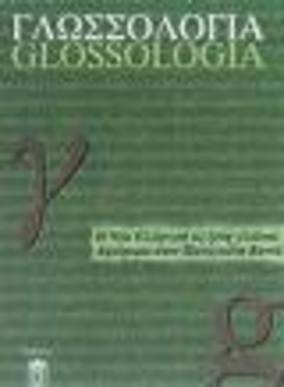Verbal collocations in Modern Greek and English : common patterns
Part of : Γλωσσολογία ; Vol.21, 2013, pages 19-38
Issue:
Pages:
19-38
Author:
Abstract:
Η δυνατότητα συνάψεων ρήματος με ουσιαστικό ως άμεσο αντικείμενο διαφέρει από γλώσσα σε γλώσσα (π.χ. have/take a look στα Αγγλικά, σε αντίθεση με ρίχνω μια ματιά στα Ελληνικά). Το γεγονός αυτό οδήγησε στην άποψη ότι οι λεξικές συνάψεις είναι αυθαίρετες (Smadja 1993). Στο άρθρο αυτό αμφισβητούμε την άποψη αυτή, υποστηρίζοντας ότι η συνεμφάνιση των λέξεων είναι περιορισμένη αλλά όχι αυθαίρετη. Το συμπέρασμα αυτό προκύπτει από την παρατήρηση της εσωτερικής κανονικότητας που διέπει το σχηματισμό ρηματικών συνάψεων, όσον αφορά τα σημασιολογικά συστατικά της σύναψης (το ρήμα και το ουσιαστικό που αποτελεί το άμεσο αντικείμενό του) και τη διαδικασία της σημασιολογικής αλλαγής. Η συγκριτική ανάλυση ρηματικών συνάψεων στη Νέα Ελληνική και Αγγλική βοηθά να εντοπιστεί ο μηχανισμός του δομικού σχήματος της σύναψης, το οποίο εμφανίζει ευρεία συναψιμότητα, που περιορίζεται καθώς το ρήμα σταδιακά χάνει το σημασιολογικό του περιεχόμενο.
Subject:
Subject (LC):
Keywords:
collocational pattern, lexical decomposition, regularity
Notes:
Περιέχει πίνακες και βιβλιογραφία
References (1):
- Babiniotis/Μπαµπινιώτης, Γ. 1998. Λεξικό της Νέας Ελληνικής Γλώσσας [Dictionary of ModernGreek]. Αθήνα: Κέντρο Λεξικολογίας.Benson, M. 1990. Collocations and general purpose dictionaries. International Journal ofLexicography 3, 23-34.Benson, M., Benson E. & Ilson, R. 1986. The BBI Combinatory Dictionary of English. A Guide toWord Combinations. Amsterdam/Philadelphia: John Benjamins.Collins COBUILD. 1991. English Language Dictionary. Glasgow: HarperCollins.Cowie, A. P. 1981. The treatment of collocations and idioms in learners’ dictionaries. AppliedLinguistics 2 (3), 223-235.Cowie, A. P. (ed.). 1998. Phraseology: Theory, Analysis and Applications. Oxford: Oxford UniversityPress.Croft, W. & Cruse, D. A. 2004. Cognitive Linguistics. Cambridge: Cambridge University Press.Dowty, D. 1979. Word Meaning and Montague Grammar. Dordrecht: Reidel.Gibbs, R., Nayak, N. & Cutting, C. 1989. How to kick the bucket and not decompose: Analyzabilityand idiom processing. Journal of Memory and Language 28, 576-593.Gläser, R. 1998. The stylistic potential of phraseological units in the light of genre analysis. In A. P.Cowie (ed.), Phraseology: Theory, Analysis and Applications. Oxford: Oxford University Press,125-144.Granger, S. & Meunier, F. (eds) 2008. Phraseology: An Interdisciplinary Perspective.Amsterdam/Philadelphia: John Benjamins.Granger, S. & Paquot, M. 2008. Disentangling the phraseological web. In S. Granger & F. Meunier(eds), Phraseology: An Interdisciplinary Perspective. Amsterdam/Philadelphia: JohnBenjamins, 27-49.Grimshaw, J. 1990. Argument Structure. Cambridge, Mass.: The MIT Press.Grimshaw, J. & Mester, A. 1988. Light verbs and θ-marking. Linguistic Inquiry 19 (2), 205-232.Haegeman, L. 1991. Introduction to Government and Binding Theory. Oxford: Blackwell.Hanks, P. 2004. The syntagmatics of metaphor and idiom. International Journal of Lexicography 17(3), 245-274.Howarth, P. 1998. Phraseology and second language proficiency. Applied Linguistics 19 (1), 24-44. Lakoff, G. 1993. The contemporary theory of metaphor. In A. Ortony (ed.), Metaphor and Thought.Cambridge: Cambridge University Press, 202-251.Lakoff, G. & Johnson, M. 1980. Metaphors we Live by. Chicago: Chicago University Press.Levin, B. & Rappaport, M. 1991. Wiping the slate clean: A lexical semantic exploration. In B. Levin& S. Pinker (eds), Lexical and Conceptual Semantics. Oxford: Blackwell, 123-151.Levin, B. & Rappaport-Hovav, M. 2005. Argument Realization. Cambridge: Cambridge UniversityPress.LKN/Λεξικό της Κοινής Νεοελληνικής [Dictionary of Standard Modern Greek]. 1998. Θεσσαλονίκη:Ινστιτούτο Νεοελληνικών Σπουδών.Longman Dictionary of Contemporary English. 1987. London: Longman.Mel΄čuk, I. 1998. Collocations and lexical functions. In A. P. Cowie (ed.), Phraseology: Theory,Analysis and Applications. Oxford: Oxford University Press, 23-54.Nunberg, G., Sag, I. & Wasow T. 1994. Idioms. Language 70 (3), 491-538.Pustejovsky, J. 1992. The syntax of event structure. In B. Levin & S. Pinker (eds), Lexical andConceptual Semantics. Oxford: Blackwell, 47-80.Pustejovsky, J. 1995. The Generative Lexicon. Cambridge, Mass.: The MIT Press.Rappaport, M., Levin, B. & Laughren, M. 1993. Levels of lexical representation. In J. Pustejovsky(ed.), Semantics and the Lexicon. Dortrecht: Kluwer, 37-54.Siepmann, D. 2008. Phraseology in learners’ dictionaries. In F. Meunier & S. Granger (eds),Phraseology in Foreign Language Learning and Teaching. Amsterdam/Philadelphia: JohnBenjamins, 185-202.Smadja, F. 1993. Retrieving collocations from text: Xtract. Computational Linguistics 19 (1), 143-177.Thomou/ Θώµου, Π. 2006. Λεξι(λογι)κές συνάψεις στη Νέα Ελληνική ως ξένη γλώσσα [Lexicalcollocations in Modern Greek as a foreign language]. Διδακτορική διατριβή. ΤµήµαΦιλολογίας, Πανεπιστήµιο Κρήτης.Walker, C. 2008. Factors which influence the process of collocation. In F. Boers & S. Lindstromberg(eds), Cognitive Linguistic Approaches to Teaching Vocabulary and Phraseology. Berlin:Mouton de Gruyter, 291-308.




